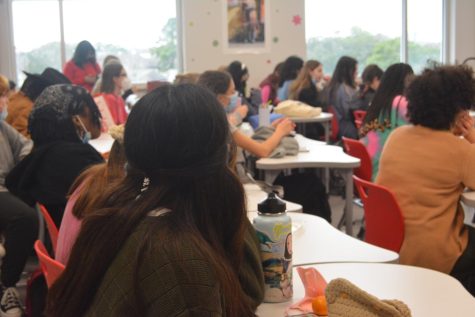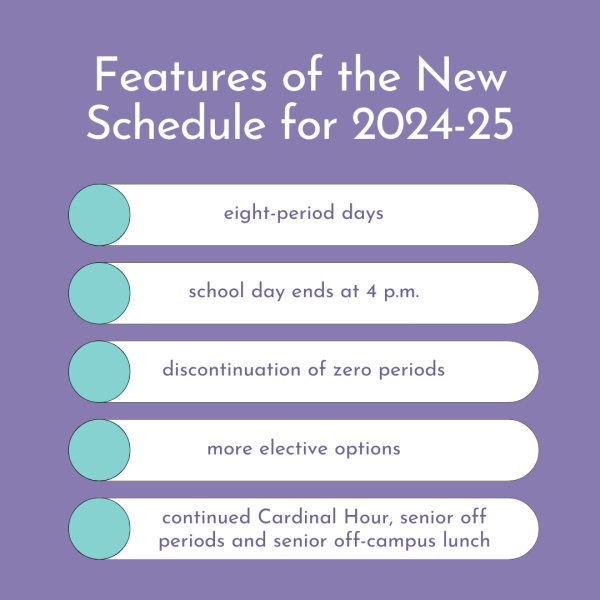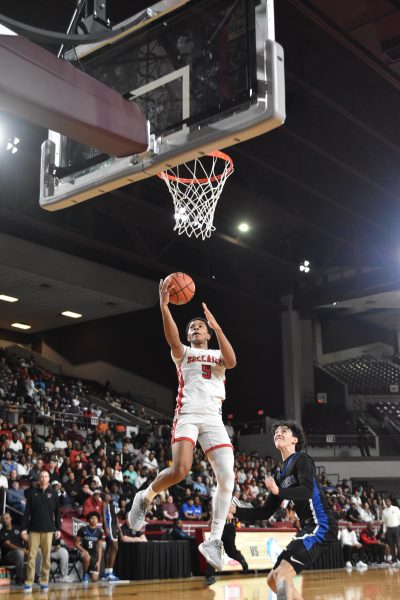‘Do women have to be naked to get into the Met. Museum?’
Feminist Club showcases feminist art during member meeting
Feminist Club members eat lunch during Cardinal Hour on February 25 while viewing a slideshow highlighting feminist art throughout history. The showcased paintings, posters, advertisements, etc ranged from 1960’s to 21st century art.
To highlight feminist art throughout history, Feminist Club members met in Ms. Blessington’s room last Friday during Cardinal Hour.
The gathering gave members a chance to express their perspectives and reactions to the artwork.
“Art is a really cool way to show an issue in real time,” club president Phoebe Hulen said. “Looking at the progression of feminist art, you’re able to see the different waves of feminism and things that were radical for their time, which is really interesting.”
The goal of this meeting was to expose members to art through the female lens.

“A lot of art shows pieces of history that are more through the male lens,” Hulen said. “Putting women into those pieces really makes you think about the women that we don’t talk about, that we don’t hear about. Even if people didn’t necessarily have things to say in the meeting I think it’s really important to expose them to these types of art.”
Hulen’s favorite piece showcased at the meeting was Untitled (It’s a small world but not if you have to clean it) by Barbara Kruger. The art features a fifties-era woman holding a magnifying glass up to her enlarged eye, and is a parody of advertisements from that time period while poking fun at gender roles and the expectation that the job of a woman is to clean.
“I definitely spend a lot of time looking at ads and all the misogyny in those 1950s ads,” Hulen said. “To see Kruger turn them around on people and make them think about the way they were portraying women, I think that’s probably why it was my favorite.”
Club sponsor and AP English Language and Composition teacher Jennifer Blessington said she also loves Kruger’s art and has seen her in exhibits before. Blessington has been interested in women’s issues her whole life and took over sponsoring the club in 2016.
“Art is an expression of the human experience and that’s why we need to have art by all different kinds of people,” Blessington said. “The way we walk through the world is going to be affected by things like our sex, race, gender, sexual orientation. When we have art that’s created by women, it illuminates the richness of the human experience.”
Another art piece that caught members’ attention was Do Women Have To Be Naked To Get Into the Met. Museum? by Guerrilla Girls for its inspirational message. The poster, featuring a naked woman donning a gorilla mask, challenged the exclusion of female artists from the Metropolitan Museum of Art.
“My favorite piece of art was the Guerrilla Girls’ piece because not only was it striking and sharp but the message behind it was that women won’t stop until we change the world,” sophomore Ariana Izaddoost said.
The Guerrilla Girls’ piece was also a favorite for sophomore Jeunesse Castela.

“It really shone light on the oversexualization of the female body in the art field,” Castela said. “I liked how it focused on how women usually don’t receive recognition unless they’re presented in a sexual way. After the meeting, I did more research on the Guerrilla Girls and not only do they fight for feminism but also against sexism and racism. They were super inspiring.”
Hulen said art is powerful because it lets the artist say things in a different way. Being able to put issues into art instead of words allows other people to interpret it in different ways.
“People can put their own thoughts into it, and when they talk about the art they bring up points of the issue that maybe the artist wasn’t even thinking about,” Hulen said.
Feminist Club welcomes members all year round. Students are free to join at any time should they be interested.
“We provide a space to discuss and go into different feminist issues,” Hulen said. “We bring in speakers and have discussion meetings similar to this one. We also do service projects like working with the Houston Area Women’s Center and fundraising for them.”
For Women’s History Month, the Feminist Club will meet on March 4, collaborating with the Student Council to view a feminist film covering the post-WWII era of women entering the workforce. For updates on meetings, join their Remind by texting @yayfemclub to 81010 or visit their Instagram page at @bhs.femclub.




![The next solar eclipse visible in the US will occur in 2033 in Alaska. At least I’ll be alive in 40 years to see the next [eclipse],” junior Eric Stevenson said.](https://threepennypress.org/wp-content/uploads/2024/04/8EF06B43-69CB-485D-A5F1-0DC4A5AE43AE-480x600.jpg)






